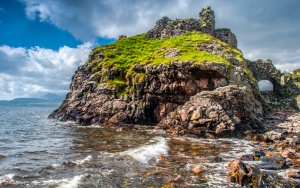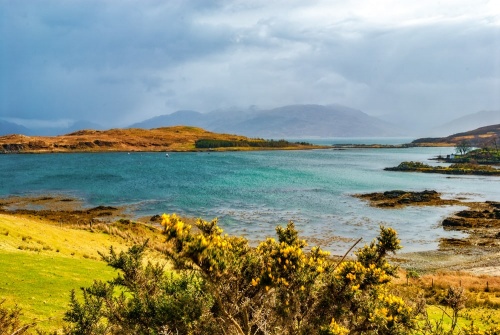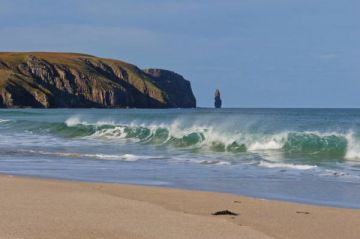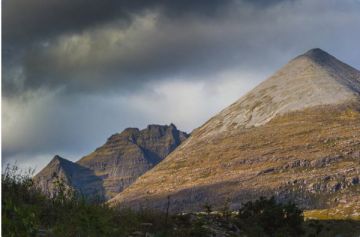
Dunscaith Castle
Travel the twisting, winding road south from the beach at Ord and you come to Dunscaith, or more properly, Dun Sgathaich (Dun of the Shadow), a 13th-century stronghold. Here, the ruins of Dunscaith Castle perch on a low headland, reached by a narrow bridge across a steep gully.
The gully is man-made, hewn from the rock of the headland, and it is spanned by arches six feet apart. The gap between the arches would have been covered by a drawbridge, gone now, which could be withdrawn in time of trouble, making the approach to Dunscaith almost impossible for attackers to breach.
The castle is the legendary fortress of the Celtic goddess Scathach, "the Shadowy One", and legend tells that it was built in the course of a single night.
Only the very adventurous and surefooted will want to try the narrow passage across the causeway to the castle proper, but the ruins can be appreciated from the shore, where waves crash against the rocks in a view that seems like it comes from the cover of a dark, Gothic romance novel.

Isleornsay
There are two ‘Ornsays’; the island of Ornsay, and the pretty fishing village of Isleornsay. The island, which contains the ruins of a medieval nunnery, can be reached at low tide on foot or by boat from Isleornsay. The village has interest for visitors; an art gallery, a craft shop, and hotel cater to travellers, but if you wander along the coast towards the nearby village of Camuscross you will be rewarded with wonderful views to Ornsay and across the Sound of Sleat to the Scottish mainland.
On the little islet of Eilean Sionnach, linked to Ornsay, stands a lighthouse first erected in 1857. In the days of steam, the village of Isleornsay was a popular resort, used by steamers to Glasgow, but now it relies on tourism and fishing, and provides a good centre for exploring the Sleat peninsula.

Armadale Castle Gardens
Armadale Castle was at various times the home of the MacDonalds of Skye. The castle was begun in 1790 and greatly expanded in 1815. Unfortunately, the bulk of the castle was ruined in a disastrous fire in 1855, and it was eventually left to moulder. It is now a glorious shell, surrounded by 40 acres of restored formal gardens. Within the gardens is the Museum of the Isles, a collection of exhibits and artefacts telling the tale of the Lords of the Isles and the history of Skye.
The remarkably mild climate of this area provides the perfect habitat for a wide variety of plants from around the world. Here, paths lead through terraced walks, past herbaceous borders and ponds, with further nature trails and woodland walks leading away from the formal garden areas. Climb above the castle and walk along the ridge above Armadale for glorious views across the Sound of Sleat to the mainland of Scotland.

Ord
Ord is a lovely small community perched on the western shore of the Sleat peninsula. Unless you have a boat there is only one way to reach Ord; a narrow road winds across the Sleat from just south of Isleornsay, following, for the most part, the valley of the River Ord.
There is a small, sandy beach here, one of the few to be found on Skye, which offers wonderful views across Loch Eishort to the peaks of the Black Cuillins. Just to the north of Ord are the historic ruins of an early chapel, while just a mile south is dramatic Dunscaith Castle.

Knock Castle
On a promontory at Teangue, north of Armadale, the dramatic ruins of this 15th-century keep are the suitable home for ghostly legends of a green lady who is said to haunt the castle. This green lady, or gruagach, is something of a barometer for the fortunes of the castle owners; if the ghost is happy, good fortune is ahead, but if she is seen to weep, then bad news is on its way! Knock, or Caisteal Camus as it is also known, was built by the MacLeods on the foundations of an earlier dun.
The castle was captured by the MacDonalds, Lords of the Isles, then, in 1421, it was taken by the royal troops of James I. The MacDonalds rebuilt the castle in 1596, and it was in use until 1689, but then fell into disrepair and the stone was used for nearby buildings, leaving Knock a derelict ruin, but one that evokes a sense of drama and mystery.



